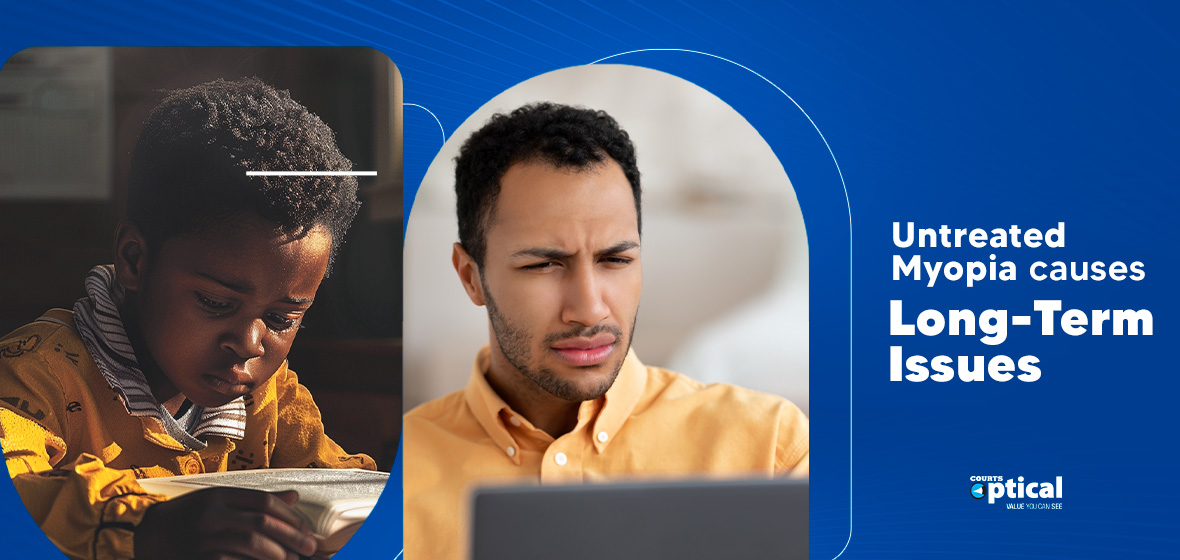Myopia, commonly known as near-sightedness, affects millions of individuals worldwide. It occurs when the eyeball is too long or the cornea is too curved, causing light to focus in front of the retina instead of directly on it. This results in blurry distance vision while close-up vision remains clear. While myopia can be corrected with glasses, contact lenses, or surgery, leaving it uncorrected can have significant consequences on eye health and overall well-being.
Let’s delve deeper into what happens when myopia is left uncorrected, and the potential risks involved.
Visual Impairment and Reduced Quality of Life
One of the most immediate impacts of uncorrected myopia is visual impairment. Individuals with uncorrected myopia struggle to see distant objects clearly, which can hinder daily activities such as driving, watching TV, or recognising faces from a distance. This can lead to frustration, inconvenience, and a reduced quality of life.
Strain and Fatigue
Uncorrected myopia often leads to eye strain and fatigue, particularly during activities that require focusing on distant objects for prolonged periods. This strain can cause headaches, squinting, and discomfort, making tasks like reading road signs or presentations challenging and uncomfortable.
Increased Risk of Eye Conditions
Leaving myopia uncorrected can increase the risk of developing more serious eye conditions over time, including:
- Eyestrain: Constant straining to see distant objects can lead to chronic eye strain and discomfort.
- Retinal Detachment: High myopia (severe near-sightedness) is associated with an increased risk of retinal detachment, a serious condition that requires immediate medical attention to prevent vision loss.
- Glaucoma: High myopia is linked to a higher risk of developing glaucoma, a group of eye conditions that can lead to optic nerve damage and vision loss.
- Cataracts: Myopia is also associated with an earlier onset of cataracts, a clouding of the eye’s lens that can impair vision.
Impact on Academic and Professional Success
Uncorrected myopia can affect academic performance and professional success. Children with uncorrected myopia may struggle in school, affecting their ability to learn and participate in activities. Adults may find it challenging to excel in their careers, especially if their job requires good vision.
Social and Emotional Consequences
Living with uncorrected myopia can also have social and emotional consequences. Individuals may feel self-conscious about their vision impairment, affecting their confidence and social interactions. They may also experience frustration or embarrassment when unable to participate fully in certain activities due to poor vision.
The Importance of Corrective Measures
To mitigate the risks associated with uncorrected myopia, it’s crucial to seek appropriate corrective measures. This can include:
- Glasses: Prescription eyeglasses are a common and effective way to correct myopia.
- Contact Lenses: Contact lenses offer a convenient alternative to glasses, providing clear vision without the bulk.
- Refractive Surgery: Procedures like LASIK or PRK can permanently reshape the cornea to correct myopia.
Regular eye exams are essential for the early detection and diagnosis of myopia, as well as the most suitable corrective option. By addressing myopia promptly, individuals can enjoy improved vision, reduced eye strain, and a lower risk of developing serious eye conditions.
Uncorrected myopia poses significant risks to eye health, quality of life, and overall well-being. From visual impairment and eye strain to increased risks of serious eye conditions, leaving myopia untreated can have far-reaching consequences. Seeking timely corrective measures through eyeglasses, contact lenses, or refractive surgery can significantly improve vision and reduce the potential risks associated with uncorrected myopia.
Don’t wait—prioritise your eye health and schedule regular eye exams with Courts Optical to ensure optimal vision and eye care.





